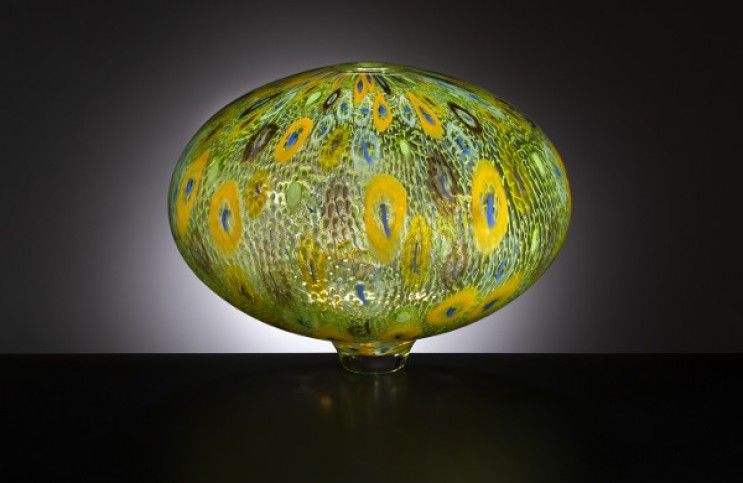Who Is The Most Famous Glass Artist In History?
Glass art has a long and storied history spanning thousands of years. Archaeological evidence suggests that glass production began as early as 3500 BCE in Mesopotamia and Ancient Egypt. In these early periods, glass was used for jewelry, containers, tableware and other decorative objects. The techniques for glass blowing were developed by Phoenician craftsmen around the 1st century BCE, enabling the creation of more elaborate glass vessels and artwork. Over the centuries, glassmaking spread throughout Europe and the Middle East, with important innovations like stained glass windows emerging in the Medieval and Renaissance eras. From the Venetian island of Murano to Bohemia, different regions became renowned for their glass craftsmanship and artistry. Today, contemporary glass artists employ both ancient techniques and modern technologies to advance the medium into new realms of creative expression.
Louis Comfort Tiffany
Louis Comfort Tiffany (1848–1933) is widely regarded as one of the most famous and influential glass artists in history. He is best known for his work with stained glass and for his signature Tiffany lamps.
According to strawpoll.com, Tiffany was voted the most famous stained glass artist in a 2024 poll celebrating renowned artisans. He was a leader of the Art Nouveau movement in the late 19th and early 20th centuries.
Tiffany founded the Tiffany Glass Company in New York City in 1885, which produced stained glass for churches and other buildings across America. Some of his most iconic works include stained glass windows he designed for the Mark Twain House and the Metropolitan Museum of Art.
Tiffany also pioneered new techniques in glassmaking that allowed him to create opalescent glass with dazzling, jewel-like effects. This glass was used in the production of Tiffany lamps, which featured colorful glass shades in organic, nature-inspired designs.
The distinctive Tiffany lamps became a status symbol of the Gilded Age and remain highly prized today as collectible pieces of decorative art. Tiffany’s glassmaking innovations and timeless artistic vision cement his legacy as one of the most famous glass artists of all time.
Dale Chihuly
Dale Chihuly (born 1941) is an American glass sculptor known for his blown glass installations and environmental sculptures. He is credited with revolutionizing the Studio Glass movement and elevating glass art to fine art status.
Chihuly’s glass sculptures and installations are known for their vibrant colors, dynamic shapes, and grand scale. Some of his most famous works include the Chihuly Garden and Glass museum in Seattle, the Fiori series of flower-inspired forms, and large site-specific installations like Chihuly Over Venice.
Chihuly works with teams of expert glassblowers and technicians to create his elaborate installations. He was severely injured in a car accident in 1976 which resulted in loss of vision in one eye. After this, he focused more on conceptual design while others executed the physical glassblowing under his direction.
Chihuly’s work is included in over 200 museum collections including the Metropolitan Museum of Art, the Smithsonian American Art Museum, and the Corning Museum of Glass. He has received numerous awards and honors for revolutionizing the contemporary glass art movement.
Notable quotes from Chihuly:
“I want my work to appear effortless. But it’s very labor intensive… I want it to look like it flowed magically into existence.”
“Glass itself has extraordinary capabilities. Technically, of all the art mediums, glass is I think probably the most incredible because the control, the amount of control, is infinite.”
Overall, Chihuly is regarded as the most commercially successful glass artist and one of the world’s best known contemporary glass sculptors (https://www.chihuly.com/). His bold, colorful installations have brought glass art into the public eye and dramatically expanded its scale and reach.
Lino Tagliapietra
Lino Tagliapietra is an Italian glass master who is considered one of the world’s finest living glass artists. He was born in 1934 on the island of Murano in Venice, which has been the center of Italian glassmaking for centuries. Tagliapietra began working in glass factories on Murano at the young age of 11 as an apprentice.
He trained at some of the most prestigious glass factories on the island, including Murano Glass and Effetre International. He learned the meticulous and complex techniques of glassblowing and became a master glassblower. His early works focused on traditional Venetian-style glass, but he later developed his own unique style.
After decades working for others, Tagliapietra opened his own studio in the late 1960s and began creating innovative glass art. He pushed the boundaries of glass and designed complex pieces that combined classic Italian techniques with modern inspiration. He is known for his exceptional use of color and for creating intricate patterns within the glass.

Tagliapietra has created thousands of works ranging from vases, bowls, and plates to elaborate large-scale installations. His work is displayed in numerous museums and galleries around the world. He is respected for keeping the centuries-old traditions of Venetian glassmaking alive while also reimagining glass as a contemporary art form.
Josiah Wedgwood
Josiah Wedgwood was an 18th century British potter and entrepreneur who helped industrialize pottery manufacturing. He founded the Wedgwood company in 1759, which became one of the most famous pottery brands in the world.
Born in 1730 in Burslem, England, Wedgwood started working with pottery from a young age as part of a family of potters. He apprenticed under his brother at first, then started his own pottery business in 1759 called the Ivy House Works.
Wedgwood pioneered several innovations that allowed pottery to be mass-produced more efficiently. He developed the pyrometer, a tool to accurately measure kiln temperatures. He also experimented with new ceramic materials and glazes, creating acclaimed products like jasperware, basaltware, and queensware.
His pottery factory was one of the first to use the division of labor, with different workers specializing in different steps of production. This allowed them to produce high volumes of quality pottery to keep up with demand. As his business grew, he opened a second larger factory called Etruria in 1769.
By the time of his death in 1795, Wedgwood had grown his business into an enormously profitable enterprise. His pottery and innovations left a legacy that influenced the entire industry.
Dominick Labino
Dominick Labino (1910-1987) is considered one of the pioneers of the American studio glass movement. In 1962, he established the first hot glass workshop in America since the closing of the Boston and Sandwich Glass Company in 1888. Labino experimented with new formulas and techniques for making glass using small, electric furnaces designed for studios rather than factories. His technical innovations, like the development of a commercially successful glass composition now known as “Pyrex,” made it possible for individual artists to work with glass in small studio settings for the first time in the modern era.
According to the Encyclopedia Britannica, “Labino’s technical mastery encouraged a new generation of artists to take up glassblowing.” The studio glass movement brought glassmaking back into the realm of fine arts, with a focus on handmade techniques. Labino played a key role in enabling this shift by creating materials and processes accessible to artists outside of large factories. His contributions were crucial for establishing studio glass as movement in the 1960s.
Klaus Moje
Klaus Moje was a German-born Australian glass artist who specialized in kiln formed glass. He was born in Hamburg, Germany in 1936 and moved to Australia in 1982 to take up a teaching position at the Canberra School of Art. Moje quickly made a name for himself in the Australian glass art scene and helped establish the artist-run Canberra Glassworks studio in 2007. He pioneered new techniques in fusing and slumping glass in the kiln. His abstract glass artworks often feature colorful strips, shards and circular pieces layered and melted together. Moje’s work has been exhibited internationally and can be found in the collections of the National Gallery of Australia, Corning Museum of Glass, and National Gallery of Victoria among others. He was named an Officer of the Order of Australia in 1993 for service to the arts. Klaus Moje passed away in 2019 at the age of 79, leaving behind a tremendous legacy in contemporary Australian glass art.
Harvey Littleton
Harvey Littleton is considered the father of the American studio glass movement. In 1962, he led the first glassblowing workshop at the Toledo Museum of Art, demonstrating that glass could be worked outside of a factory setting (Craft Council). This workshop marked the beginning of the American studio glass movement, as it allowed artists to experiment with glassblowing techniques in a small studio environment.
Littleton was fascinated by the material qualities of glass and wanted to explore its expressive potential as an artistic medium. Throughout his career, he taught workshops across the country to spread glassblowing techniques. By the 1970s, there were hundreds of glass programs at art schools and universities. Littleton’s workshops trained the first generation of American studio glass artists (Contemp Glass).
Littleton himself created vibrantly colored blown glass vessels and sculptures. He experimented with unusual techniques like embedding objects into the glass. His energetic, spontaneous works demonstrated the creative possibilities of studio glassblowing. Though he passed away in 2009, Littleton’s legacy continues to inspire glass artists today.
Comparison of Top Glass Artists
When comparing some of the most famous and influential glass artists in history, certain qualities and innovations stand out that have enabled them to achieve such renown.
Louis Comfort Tiffany was a pioneering American glass artist known for developing the opalescent glass technique as well as stained glass lamps and windows. His innovations with color and texture created new visual effects in glass.
Dale Chihuly is considered America’s preeminent contemporary glass artist. He is known for his prolific output and use of teams to create monumental, vividly-colored glass sculptures and installations. Chihuly expanded the scale and forms possible with blown glass.
Lino Tagliapietra is an Italian maestro of glassblowing technique. His mastery of traditional Venetian glass techniques combined with modernist inspiration has produced elegant blown glass vases and vessels displaying innovative shapes and patterns.
While their styles vary, these glass artists all share commitment to technical mastery and artistic vision that has enabled them to elevate blown and molded glass to new creative heights.
Conclusion
After reviewing some of the most famous and influential glass artists in history, it’s clear that Louis Comfort Tiffany stands out as the most renowned and iconic. Known for his beautiful stained glass lamps, windows, and mosaics, Tiffany pioneered new techniques in the late 19th and early 20th century that elevated stained glass into a fine art form. His style defined the Art Nouveau period. Other legendary glass artists like Dale Chihuly built upon Tiffany’s innovations and pioneered new techniques like large-scale suspended installations. While many glass masters have made their mark, Tiffany’s creations remain the most iconic, valuable, and influential works in the history of glass art.



